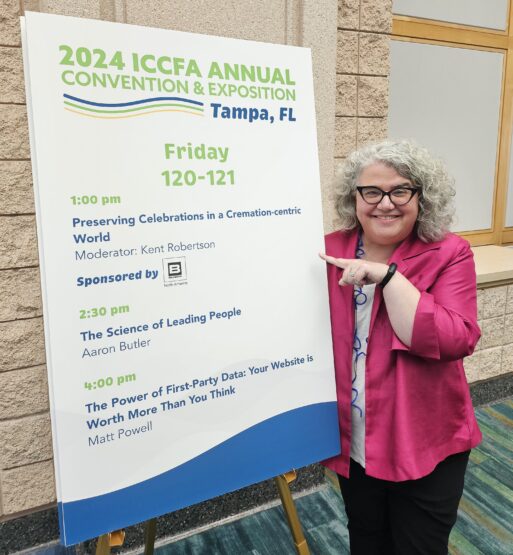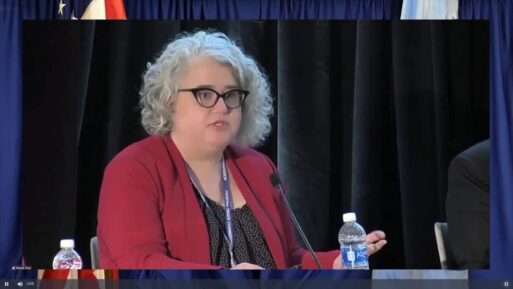
Kemmis at the International Cemetery, Cremation & Funeral Association Convention and Expo.
Barbara Kemmis is the Executive Director of the Cremation Association of North America (CANA) and has been with the organization for 13 years. Her 111-year old association has witnessed a lot of change in the deathcare industry over the years. SevenPonds spoke with Kemmis recently about the increasing appeal of cremation for final disposition, and two new options that are now available in a handful of states — Natural Organic Reduction (NOR), also known as human composting, and Alkaline Hydrolysis, a water-based method, also referred to as hydromation.
Editor’s note: This interview has been edited for length and readability.
First of all, Barbara, tell us what drew you to this association?
My background is in library science. And I didn’t think I’d ever work in anything else, but someone told me about an opening at CANA and suggested I give it a shot.
How did it go?
I thought I screwed up the interview! I was out of practice. It was a boardroom kind of setting with all these guys in black suits and one woman named Cheri for support. And I thought, “Oh, this isn’t for me.” I’m used to being a librarian, right? But halfway through the interview, I thought, “I like these people. They’re entrepreneurial, they’re caring. The challenges that they’re facing are really fascinating too.”
Fortunately, I didn’t screw up as badly as I thought, and they offered me the job. It turned out they were just as fascinating and caring and responsive to their communities as I imagined in that interview. And 13 years later, I’m not bored yet and I’m still enjoying the job.
When did cremation start to become a popular option in the United States?
Cremation was introduced in the U.S. in 1876 and it took nearly 100 years, until about 1971, for the cremation rate to reach even 5%. And then from 1971 to 2016, it grew to exceed 50%. Our most recent statistics show that it climbed to 59% In 2022. And that was 100% driven by consumers, not marketing.
Why the rapid change in the late 20th century?
We could point to Vatican II (the ecumenical council of the Catholic Church that approved cremation for Catholics). We can point to the Baby Boomer generation choosing alternatives to what their parents had. We can point to all these societal influences. Plus, the fact that it’s less expensive than a traditional burial. But the point is that the cremation profession didn’t encourage it. People chose it. We’re simply trying to understand and keep up with consumer demand for cremation.
Where do you see the trend topping out?
We’re anticipating things will plateau in the U.S. at 80%. Of course, it varies by region. Maine, Nevada, Washington and I think Florida recently exceeded 80%. On the other hand, Mississippi and Alabama are around 40%.
While cremation conserves real estate and is considered greener than burial because it doesn’t involve embalming fluids, some critics have pointed out that it does have a carbon footprint. You’re burning fossil fuels to turn a body to ash. Have any strides been made to reduce the carbon footprint?
I think it’s a pretty small minority that’s concerned with carbon emissions, but the industry is trying to improve efficiency. The transition has been slow because the machines last a very long time. New technology is coming and some of those improvements are being applied to older machines, such as computer monitoring of stack emissions and fuel usage.
Electric cremation machines are already a technology that exists in some parts of the world, mainly Asia and some parts of Europe. They’re much more efficient. As the older machines wear out here, the electric machines will be phased in. They say it’ll take five to seven years for the industry to transition.

In recent years a new way of disposing of a body has emerged called Natural Organic Reduction (NOR), also known as human composting, which takes place in a specially designed container in a dedicated facility. Even though it’s not technically considered cremation, your organization has recognized the trend and has created professional certification for providing the service. What can you tell us about demand for this new option?
What’s really interesting to me is how the consumer demand for composting is so significant. It has been legalized in eight states; I never would have guessed it would happen this quickly. New York State is a perfect example. The governor recently signed it into law. It’s consumer demand and it’s fascinating.
What do you think is the appeal?
I think a lot of it has to do with ceremony. A lot of it has to do with participating in the laying in of the body and the laying out of the soil (after composting). It’s like going back to the early days of cremation, this kind of beauty, when the family participated in the ritual, the poetic nature of it.
How long does the process take and how much soil remains at the end?
It can take six to eight weeks or more. The remains are in the container four to six weeks. Then the bones are separated and crushed and returned to the soil, which is put through a grinder to produce an even texture. Then the soil is returned to the container for another two to four weeks. What’s left is approximately a cubic yard of soil that’s environmentally safe and beneficial.
Alkaline hydrolysis is a newer option that’s considered “greener” than flame-based cremation. Although it’s just getting attention now, it has been around a while, hasn’t it?
It was patented in 1888 by Amos Herbert Hanson, a farmer who was looking for a way to make fertilizer from animal carcasses. In 1993, the first commercial system was installed at Albany Medical College to dispose of human cadavers. The process continued to be adopted by universities and hospitals with donated body programs over the next 10 years. The process was first used in the funeral industry in 2011 by two different funeral homes – one in Ohio and one in Florida.
How does it work?
A water-based dissolution process that combines alkaline chemicals, heat, agitation, and pressure, is used to accelerate natural decomposition. It reduces human remains to bone fragments and a neutral liquid called effluent. It’s actually sterile and there’s no tissue or DNA left when the process is finished.
Your website states that city waste management systems actually view it as a positive. How is that?
That’s right. It’s because the liquid that’s produced is alkaline, and waste management systems typically add chemicals to increase alkaline levels to balance out the acidic nature of sewage. So, if alkaline hydrolysis became popular, it would actually save them money.
How popular is the practice now?
Right now, of the 3 million deaths in any given year, 60% will be cremated, 37% will be buried, including green burial, and the remaining 3% is “other,” the majority of which is medical donation. And a tiny sliver of that is alkaline hydrolysis, so it barely moves the needle.
I’ve read that there has been some pushback on alkaline hydrolysis from critics, particularly from the Catholic church, who claim it’s undignified.
Right. There’s a certain “ick” factor. The liquid is disposed of like any other medical waste into the sewage system. Some people have described it as “flushing grandma down the drain.” But others like it because it’s a greener option, there aren’t any toxic chemicals used, and it’s less expensive than traditional cremation.
It’ll be interesting to see what other options may arise in the future. What would be your advice to CANA members going forward?
Change is going to happen driven by consumer wishes, so let’s be involved in the conversation to make sure these things can be done safely and in a dignified manner.

 Adapting to Changing Trends in the Deathcare Industry
Adapting to Changing Trends in the Deathcare Industry


 How Dare You Die Now!
How Dare You Die Now!
 Debating Medical Aid in Dying
Debating Medical Aid in Dying
 “Help Me, Helen”
“Help Me, Helen”














